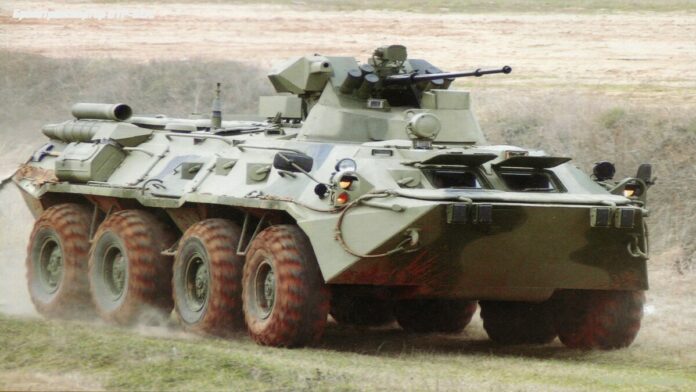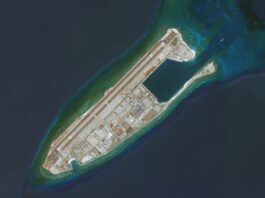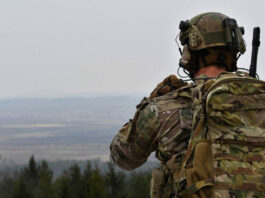BTR-82 become very widely known since the full scale invasion of Ukraine, which took place on 24th of February 2022. However, the roots of this vehicle go deep back into the Cold War and the Soviet Army doctrines.
Article Contents
The roots of the BTR-82 concept
Since the creation of BMP-1, which is wrongfully considered as the first infantry fighting vehicle, the doctrine of armored personnel carriers have somewhat shifted. Before, all armored vehicles of such class were supposed to deliver infantrymen to the battlefront, essentially acting as taxis.
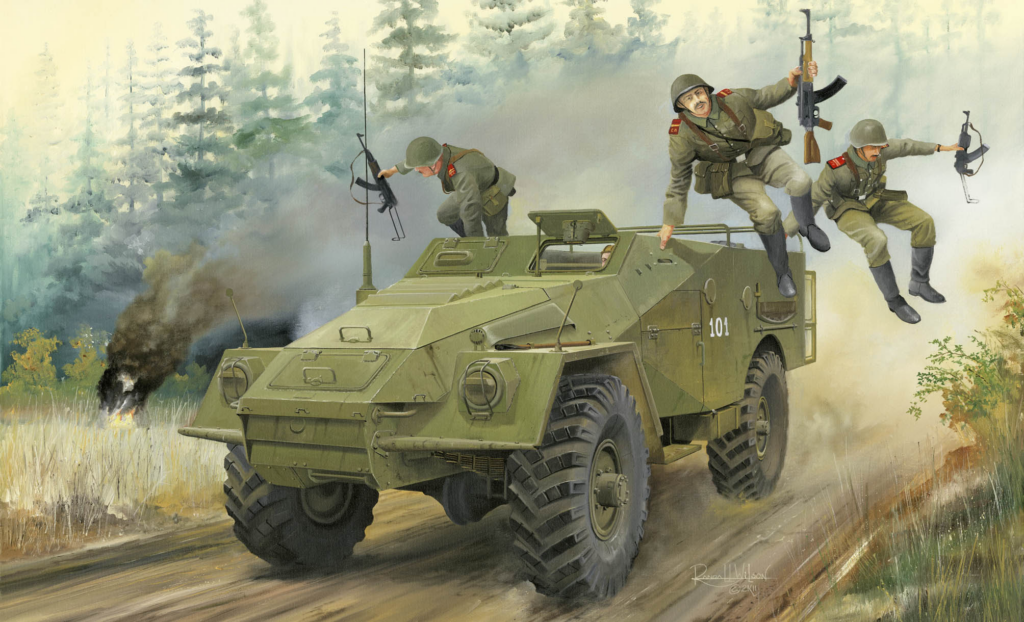
This was the concept which was used across most well motorized armies in 1940s and 1950s. However, things started to shift with the new doctrine of Atomic war. The armies started to modernize in order to be ready to perform in case of nuclear fallout. One of the key elements of the atomic warfare was to conceal soldiers. Modernizing tanks or aircraft for such task was relatively easy, but not the infantry. Most infantry vehicles (trucks, half-trucks, APCs etc) usually had open top. So when the top was finally latched, these vehicles, such as BTR-60 became capable of carrying weapons heavier than a regular machine gun.
On top of that, a new armored vehicle concept was adopted around the same time. I am talking about the infantry fighting vehicles and it’s first examples – West German HS.30 and Soviet BMP-1.
IFV and APC development in the Soviet Army
By late 1960s Soviet infantry was generally split in two parts. First part could be called mechanized, as these regiments were mainly armed with BMP-1, featuring both a 7.62 PKT machine gun and a powerful 73mm 2A28 “Grom” cannon. Other regiments could be considered motorized – they were equipped with BTR-60. Its armament consisted only of the machine guns – 7.62 PKT and 14.5 KPVT. While KPVT is a high-caliber weapon, it’s limited anti-armor capabilities and small ammunition load (500rd) made this vehicle incapable of reasonable infantry support on a modern battlefield.

There were two schools of thought in the Soviet Army Command. One team was pushing for the idea to equip all regiments strictly with the BMP-1. Others were more into idea of having both vehicles simultaneously. As we know, the second team won and both families of vehicles – BMPs and BTRs continued to serve in the forces. The main reason for this was the poor state of the Soviet economy. The USSR could not afford to re-equip its forces with BMP-1, as it was incredibly expensive. The price for one BMP-1 was the same as for twenty GAZ-66 trucks.
To solve this problem, Soviet industry has proposed a new solution – to install a more powerful battle turret on the existing and cheap BTR-60 platform.
Wheeled vehicle with turret as predecessor of BTR-82
The solution proposed was the little known GAZ-50 experimental vehicle. In practice it was just a combination of BTR-60 platform with the turret, which had all the same weapon systems as the BMP-1.

This particular vehicle never made it to the mass production line, thought it was used later on to produce BTR-70. However, it did lay the concept of having not tracked, but wheeled vehicle with powerful armament.
The concept was never used in the Soviet Army, mainly for the economical reasons. The Soviet Army was just too big. Even the BTR-80, which was developed after the beginning of the Afghan war had exact same combat capabilities as its much older brother – BTR-60P.
BTR-90
However, our story will not be full without this one last vehicle. The need for BTR-90 rised in Soviet Period, during the Invasion of Afghanistan. However, it was developed much later, in the 1990s.

The vehicles and was much better than both BTR-80 and the future BTR-82. It had better armor and armament, yet the russian army was too poor to purchase them in any meaningful numbers. This vehicle requires it’s own in-detail article, which we will add shortly.
The BTR-82 and it’s problems
So, by the late 2000s, Russian army was not that different from it’s Soviet predecessor in mid 1980s. The bulk of the mechanized and tank regiments were equipped with BMP-1 or BMP-2, troops were transported by BTR-80 and supported by T-72. Very few battalions equipped with newer, yet still outdated and problematic BMP-3 or T-90. So the Russian command decided to improve the BTR fleet to at least some new level.
To do this, they decided to do what their Soviet predecessors had in mind – to install powerful cannon on top of the BTR. But instead of adopting a more or less adequate BTR-90, they decided to cheap out and asked the Arzamass Machine Factory to come up with a cheaper alternative. And so the BTR-82 was created.
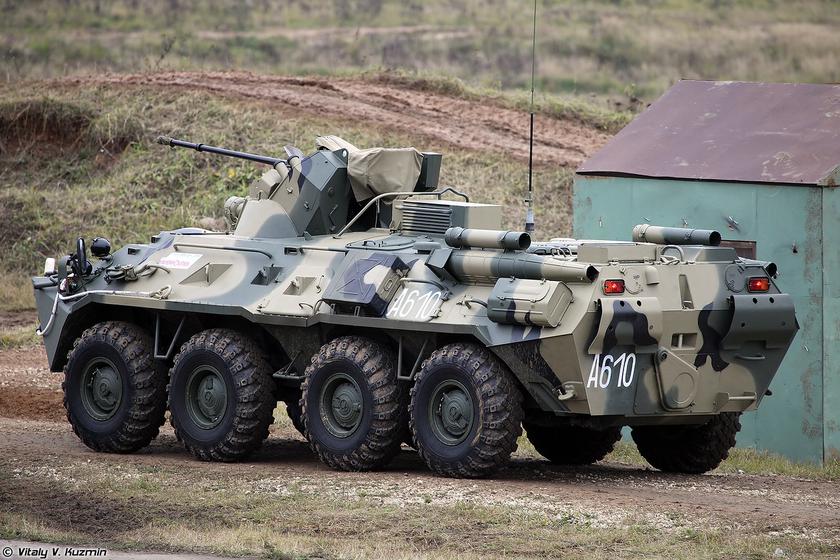
Now, it is important to note, that BTR-82 have exactly two bis pros.
Firstly, unlike with BMP-3 or T-90, Russians actually managed to produce a good number of them. The military balance stated above one thousand and Ukrainians managed to destroy and capture more than 400 so far, so the initial thousand seems plausible.
Secondly, it is actually much better than BTR-80 simply due to a more powerful 2A72 auto-cannon.
But that’s about it. In a nutshell – it is just a BTR-80 with a better cannon.
So the BTR-82 has all the cons of the classical BTR family:
- Dismounting doors are located on the side. While this idea is generally retarded for any setup, the door on BTR-80/82 is located between two wheels, which actually puts a dismounting infantrymen in great danger if the vehicle is on the move
- Thin armor. The BTR-90 had at least some meaningful protection against 12.7mm weapons. BTR-82 does not – it can be crushed in pieces using a Browning M2. Especially on the side. Anything bigger just annihilates it.
Now on top of that, BTR-82 has some new problems: - The 30mm auto-cannon is not the same one as was used on BMP-2. It is 2A72, which uses a different mechanism (long barrel movement) to reload. The 2A72 cannon is basically a worse version of 2A42 – simply because of its rate of fire. The cannon installed on BTR-82 only shoots 330 rds/min
- No ATGMs. Almost any modern infantry fighting vehicle is equipped with high end anti-tank capabilities. For example, Ukrainian counterparts – BTR-3 and BTR-4 are both equipped with couple of anti-tank rockets each. In theory, the 30mm cannon can be used against tanks, but due to low rate of fire the success is somewhat questionable. It will attract the tank to shoot back though!
- Lack of a modern situational awareness electronics
- No adequate optics. BTR-82 is not equipped with neither a modern night scope, nor with any thermal sights. There is a good video which shows how this ends up:
Summary
The article is called “failure to modernize” and this phase describes the BTR-82 perfectly well. While having all the necessary tools, machinery and ideas and without being under sanctions, Russian Army failed to adopt the correct vehicle for its own good. Now, fighting a very complicated war with Ukraine, they are placing their soldiers in great danger by sending them to the front line in ridiculously outdated personnel carriers.

